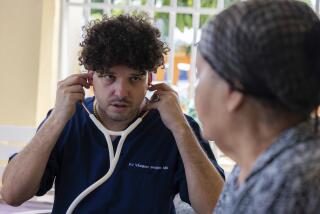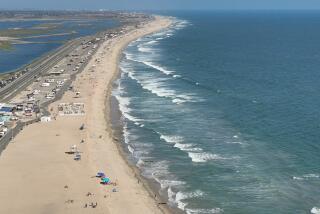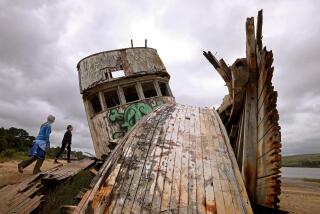Puerto Ricoâs Little Sister
VIEQUES, Puerto Rico â Where Iâm sitting, I canât see four people. Iâm in the open-air bar of Trade Winds, my $40-a-night guest house, looking across the street at an empty beach on the Caribbean Sea--an hourâs boat ride from 4 million people. The sun in a cloudless sky is splashing an ocean so blue and clear I can see coral reefs 10 feet below the surface. As I sip punch made from a superb rum I canât even find in the United States, I see two cars pass in an hour. Only three other rooms are occupied.
Less than 40 miles away to the west, people jam casinos in San Juan. Twenty miles to the east, package tourists are stuck in traffic in St. Thomas. In between, the little island of Vieques stretches 21 miles long and six miles wide. It has 42 beaches--one for every day of the month, plus a few spares, should you encounter another person on a beach and wish for one that is totally deserted. Commercialization in Vieques is a snorkel rental shop where the owner lets you return fins on his sun deck after hours.
âYou canât suffer cardiac arrest here,â said one local bartender. âThereâs no such thing as stress.â
Vieques (pronounced vee-A-kess) was discovered by Columbus on his second voyage and settled by Taino Indians, who called it Bieques or âsmall islandâ in the Arawak language. Today, itâs governed by Puerto Rico. But of the 9,000 people on Vieques, about 1,000 are transplanted Americans, âmainlanders,â as they call themselves. Theyâre a collection of corporate dropouts, sailing junkies and free spirits.
Ian Hughes is a Brit, who ditched his job as a Chicago steel company executive in 1994 to sail the Caribbean. He charters sailing trips from Bermuda to Trinidad and Tobago, and he anchored his boat off Esperanza, a small village on the southern coast. I met Hughes in Esperanza at Trapper Johnâs, one of the local watering holes. He was with Jan Buelow, his lady friend and first mate, and I asked him, of all the islands in the Caribbean, how Vieques rates.
âItâs our favorite place,â he said. âItâs the only island where I can guarantee an Italian honeymoon couple that weâll be the only boat on four separate bays.â
Why? Depends on who you ask. Locals trying to make a buck off the tourist trade blame the Navy. In 1940, the Navy bought two-thirds of the island (about 21,000 acres) for an ammunition storage center and bombing facility. Some feel itâs hard to attract hotel entrepreneurs when an F18 is dropping a 2,000-pound bomb. However, with the bombing area extremely restricted, even the locals agree youâd have as good a chance of spotting a tyrannosaurus as you would a live bomb.
The Navy feels that an archaic transportation system is whatâs holding Vieques back. You can reach the island only two ways: a 75-minute ferry ride or a puddle-jumper plane from San Juan. Whatever the reason, the byproduct is a laid-back, peaceful and inexpensive alternative to the dash, flash and cash that is so often the Caribbean. Charlie Caroline, a local cook, came to Vieques from St. Petersburg, Fla., six years ago and hasnât cut his hair since. Wearing a Hawaiian shirt and holding a beer in a coaster reading âWe be beaching,â Caroline summarized Viequesâ appeal.
âThereâs nowhere to go and nothinâ to do,â he said, smiling through a thick beard.
Wrong. Thereâs everywhere to go. Try some of the most flawless beaches in the Caribbean.
The Navy is right. Transportation to Vieques and on it isnât much. Publicos, the buses of Puerto Ricoâs haphazard system, are infrequent on Vieques. But renting a car is cheap, and for $25 a day I had a Jeep to take me all over the island.
You can circle Vieques in an hour, but one of the worldâs great beaches is a 10-minute walk from Trapper Johnâs. Sun Beach is half a mile long and curved to form a perfect bay. The fine, white sand had no rocks and the palm trees behind me formed a private cove. In 2 1/2 hours, the only people I saw were a Puerto Rican couple who were on my ferry that morning and a strolling teenager. As I waded into the gentle surf, I could see little fish curling around my calves.
âAs for snorkeling, nowhere compares to Vieques,â said Buelow, who says she has dipped her mask in nearly every bay, cove and channel in the Caribbean. âItâs not pretty good. Itâs fantastic.â
And this beach wasnât even the best on Vieques. The next day I drove east along Viequesâ magnificent southern coast. I passed gentle green hills with horses and cattle grazing just a Frisbee toss from the ocean. Many of the good beaches are on Navy property, which covers the eastern and western thirds of the island. But getting in didnât require complex espionage. At a crude checkpoint, a Naval officer asked to see my driverâs license and waved me on, giving me directions as I hit the gas.
Ten minutes along a dirt path, I turned right through huge mangroves and found Red Beach (pictured on page L1), one of three main beaches controlled by the Navy. The others are called Blue Beach and Green Beach, but the beaches are blah in name only.
Red Beach stretches for two miles, a string of white sand that ends at a stony cliff. Other than two Puerto Rican families eating lunch by their cars and two children swimming, I was alone with my book and beach mat. Ten minutes east, on the southern rim, Blue Beach was even more desolate. In 90 minutes, the only others on the beach were a couple taking self-portraits of themselves (using a self-timed camera) with the sky-blue sea lapping around their ankles.
As I read my book and applied another layer of sunscreen, I marveled at how close I was to the growing crime and crowds of St. Thomas. Even in Puerto Rico, they charge for parking. Parking! On two Vieques beaches over a four-hour period, I saw a grand total of 10 people. Puerto Ricans use it for a weekend and holiday retreat and the island is busier then, but you will never see a cruise ship or 747 anywhere near here.
âItâs pretty quiet all year round,â said Barbara Stevens, a waitress at La Central, a family-owned restaurant that serves a wonderful dish called pastelillo (baked turnovers filled with fish, chicken or beef). âWe have a season, but not a season like the other Caribbean islands.â
I told her about my last night in Puerto Rico, where I forked over $60 just for a cab ride to the port city of Fajardo. âIâve never been impressed with Puerto Rico,â she said. âYouâre in Puerto Rico and youâre going, âWait a minute! Weâre in New York in the summer!â â
The most tourists I saw on Vieques was on my last night when I took a boat tour of Mosquito Bay. No body of water is more misnamed. Itâs known for a phenomenon called âfire of lights.â For 30 minutes I swam and snorkeled in a bay as black as the inside of a closet, yet watched my entire body alight with sparkling microorganisms. The bay is a massive concentration of microorganisms called dinoflagellates and they flash when agitated. Itâs called a bioluminescent bay. Many âbio baysâ exist in the world. But Mosquito Bay appears to have a particularly high concentration of microorganisms, I was told, because the huge mangrove forests rimming the small bay create nutrients on which the microorganisms thrive.
For 30 minutes afterward, I saw Americans and Puerto Ricans shrieking and laughing as their bodies lighted up in silver and white bubbles.
*
I can see why so many mainlanders have taken one look at this island and punted their briefcases. Hugh Duffy has called Vieques home for 27 years. A former liquor salesman in New York, Duffy looks like an old Irish sailor who shipwrecked here and didnât bother calling for help. One appeal, he says, is the small-town atmosphere.
How small is it? I asked one of the bartenders at my guest house where I could find Duffy, and she called the Do Dive Inn bar five minutes down the street.
âHe just left,â she said. âIâll flag him down.â
She walked into the street, waved her arms and in about two minutes a car pulled up. Over a rum and soda, Duffy told me why Vieques took hold of him.
âI like it because itâs easy,â he said. âItâs easy for me. The people are fantastic. I lived in the Virgin Islands when people were fantastic. People were lovely there. It stinks there now, but itâs lovely here. Thereâs no discrimination. Iâve never felt discrimination because Iâm [not a Puerto Rican].â
However, a controversy hovers over the island like a cloud. To those who have made it on Vieques, it has a silver lining. To those who havenât--the unemployment rate is about 50%--the cloud represents storms.
Many locals want the Navy out. They say the bombing is dangerous and the reefs are being damaged. Others think the Navyâs mere presence discourages any development. At one time, the Navy and Marines had troops here, but they were pulled out in the â70s. The remaining personnel is mainly administrative and numbers a little more than 40.
âWhen I was first here, there were 5,000 Marines,â Duffy said. âThere were bars all over. Everybody made money. Now they control the same amount of land, but contribute nothing.â
Bob Rabin moved from Boston 16 years ago to work on a masterâs thesis on the presence of the U.S. military and its impact on the island. Today, he is the director of the Ft. Count of Mirasol museum and 19th century historical monument. Heâs also one of the Navyâs most outspoken critics.
âThe Navy is a major obstacle to economic development,â Rabin said. âTheyâve done extensive damage to the coral reefs and all the natural habitat on the eastern end.â
The Navy has some form of target practice--bombing, weapons testing--nearly every day, according to a Navy spokesman, although I didnât see any evidence of it during my four-day stay in June. And while they use restricted land that includes a five-mile buffer zone, Rabin claims some of the bombs miss their targets.
Officially called Naval Station Roosevelt Roads, the facility is, well, a practice area for war. Personnel who fought in Desert Storm and Bosnia received their training exam on Vieques, a Navy spokesman said.
âVieques is vitally important to the nationâs defense,â said Lt. Commander Ed Barker, the Navyâs public affairs officer on Vieques. âPeople from all over the world come down here. We had German ships here not too long ago. A lot of times this is the only place in the world where you can have this type of training and have these types of facilities. Sure, it would be great if we didnât have to do this and could give the land back to Vieques. But if youâre going to fight, you have to train.â
Barker scoffs at any mention of the Navy damaging the environment. He says that, in addition to having the five-mile buffer zone, 99% of the bombs land on target. Before they bomb, he said, the ocean is patrolled for whales and the beach is walked for leatherback turtles. If any eggs are found, theyâre placed in an incubator on the base to hatch, then returned to the area.
Just before I arrived this summer, the Navy reintroduced 130 baby turtles to the beach, Barker said. He said the Navy also helped get Mosquito Bay declared an environmental zone by the Puerto Rico Department of Natural Resources to protect it from motorboats.
As for safety, Barker said, the target areas are on isolated, heavily guarded areas. No need to worry about coming out of the water and seeing a bomb land on your beach towel. Locals say they canât even hear bombs explode.
Jim Belch is the former director of economic development for the state of Maryland, a title that included tourism. He recently left his United States home and moved into a house on Vieques.
âNo way will it ever compete with glitzy tourism,â Belch said. âNo way should it try. It should play to its existing strengths. Itâs a sleepy fishing village.â
The day I left Vieques, I found myself back in Fajardo renting a car. The rental office is in the massive, air-conditioned lobby of the El Conquistador, Puerto Ricoâs $250 million, 500-acre palace on top of a cliff. It features seven swimming pools, white-coated valets and a golf course. As I raced down the curvy, paved driveway past golfers in expensive double-knits, I started missing my little secret paradise. But I was comforted by one thought:
That secret paradise will still be a paradise when I return.
(BEGIN TEXT OF INFOBOX / INFOGRAPHIC)
GUIDEBOOK
Vieques Vacation
Getting there: Delta flies direct, with one stop but no change of planes, between LAX and San Juan. American, Continental and TWA fly there with one change of plane. Lowest round-trip, advance-purchase fares start at $670.
Isla Nena Air Service (telephone [787] 791-5110) leaves from San Juan International Airport three times a day, more if needed; $90 round-trip. Vieques Airline ([787] 722-3736 leaves four times a day from Isla Grande Airport, 20 minutes from international airport; round-trip fare, $70. Ferries leave daily from Fajardo, about 45 minutes east of San Juan; $2 each way.
Where to stay: La Casa del Frances, P.O. Box 458, Vieques 00765. Sprawling French-style mansion on a hill above Esperanza. Rates: $96-$175 for a double; tel. (787) 741-3751.
Inn on the Blue Horizon, P.O. Box 1556, Vieques 00765; on the beach with pool and ocean-view bar. Rates: $150-$175 a night for a double. Has three rooms, but is expanding to nine by end of year; tel. (787) 741-3318.
I stayed at Trade Winds Guest House, P.O. Box 1012, Vieques 00765. Across street from beach with restaurant and ocean-view bar. Rates: $50-$65 for a double, depending on if air-conditioned; tel. (787) 741-8666.
Bananas Guest House, P.O. Box 1300, Vieques 00765. Rates: $45-$65, depending on whether rooms are air-conditioned; tel. (787) 741-8700.
For more information: Puerto Rico Tourism Co., 3575 W. Cahuenga Blvd., Suite 405, Los Angeles, CA 90068; tel. (213) 874-5991.
More to Read
Sign up for The Wild
Weâll help you find the best places to hike, bike and run, as well as the perfect silent spots for meditation and yoga.
You may occasionally receive promotional content from the Los Angeles Times.






